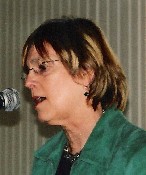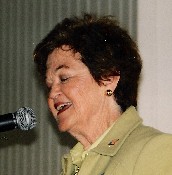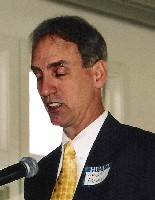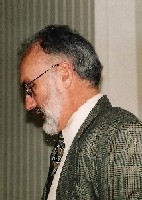
Modern Transportation for the Virginias
The Virginia Association of Railway Patrons held its annual meeting on February 25 in Williamsburg. A good number of people turned out from the Tidewater area, joined by VARP members from around Virginia. Some drove, some came by bus, but as far as we know, nobody arrived by train: Amtrak suspended trains 66 and 67 between Washington and Newport News because of CSX track work.
 |
Williamsburg, said Mayor Jeanne Zeidler, is dedicated to transportation options that get people where they’re going and damage the environment the least. The Williamsburg Transportation Center, she said, serves rail, intercity buses, and taxis and is a local bus hub. Williamsburg invites people to get around easily without cars. There’s a shuttle to hotels, to Colonial Williamsburg, to Jamestown, and to Yorktown. There are tens of miles of pedestrian and bicycle paths for transportation and recreation.
The city needs and continues to advocate improved Washington–Newport News rail service. The city wants more people to come by rail to the Jamestown 2007 celebration but may not have more rail service by next year. A six-year logistics committee has worked to plan for 2007. One accomplishment is the combined Relax & Ride bus service in cooperation with James City and William and Mary College. Combining the separate bus services into a larger, better system brought dramatic increases in ridership.
Eventually the city wants to see rail service across Hampton Roads to Norfolk and Virginia Beach.
Transportation, she said, is a problem not easily solved, but it’s important to the area’s future.
 |
The generations before us invested in the transportation infrastructure we enjoy now, according to Sheila Noll. It’s our turn to create a transportation system for future generations.
At transportation town hall meetings around the Hampton Roads area, she said, “citizens spoke loudly and clearly” for more and better public transportation, including buses, light rail, and high-speed rail. They are tired of wasted time due to clogged transportation systems, she added.
Getting in a car for all travel isolates us from our neighbors, said Noll. We need to act as a community, she said, and we need to look outside our own communities for answers. She mentioned a trip by area officials to San Diego, which has transportation planned around the nodes of light-rail stations.
Noll pointed out that the Hampton Roads area is the
That’s a pattern repeated around Virginia as population growth and economic growth outstrip the transportation infrastructure.
We need a long-term transportation funding source adjusted annually for inflation, said Noll. Business will get behind public transportation if business profits from it, she said.
She compared public opinion on transportation to a sleeping giant. We need to increase the number of voices speaking for public transportation, she said. Politicians listen, she emphasized; people need to speak. We must act as a community and each do our part for a viable multimodal transportation system, noting that it’s an issue of funding and priorities.
 |
Dwight Farmer is a transportation planning engineer. Back in 1967, he said, the
The Norfolk light rail line in the same corridor is forecast to carry 30,000 riders per day, and Farmer said that it would have a significant positive impact on travel between the area’s two biggest cities. Noting that transportation forecasts always turn out low, he ominously mentioned another forecast: by 2015, the Hampton Roads Bridge-Tunnel
Furthermore, transportation problems require long-term solutions. The Monitor-Merrimac tunnel took
Despite the problems, Farmer said, it has been a struggle to get funding for any transportation improvements. The
To put transportation spending in perspective, Farmer pointed out that each of the big auto manufacturers spends more each year on advertising than the entire federal budget for public transportation. He feels that the mentality of public investment is being lost. However, he thinks that local officials—with whom he works daily—agree with the public on the need for more and better transportation.
 |
Chapman, a Virginia Beach native, said that we are in a golden age of freight rail transportation. One train with a two-person crew hauls
Public money for infrastructure improvements is shaping the railroad’s service. Norfolk Southern’s Heartland Corridor between Chicago and the East is benefiting from a grant to increase clearance in
In the I-81 corridor, Chapman said, rail can’t absorb all the freight growth but it can reduce the need for highway expansion. Increased capacity on the Norfolk Southern line through the Shenandoah Valley could take half a million to
While enjoying a golden time with freight, Norfolk Southern is no longer saying no to passenger trains, said Chapman. By acquiring much of Conrail, Norfolk Southern became a major partner with Amtrak and commuter lines. Norfolk Southern is now deeply involved with passenger service, and the future portends more.
Now Norfolk Southern will answer yes to passenger trains if four conditions are met:
A case in point is the Trans-Dominion Express route between Bristol and Richmond. A major upgrade, costing hundreds of millions of dollars, is necessary, he said. With current track conditions, the trip from Bristol to Richmond would take
Between Richmond and Norfolk, a lot of improvements would be needed to add passenger trains to the line: signs, track, grade crossing work. Higher-speed rail still needs considerable upgrading. Trains going
The Haymarket extension of VRE service (which requires similar improvements) is likely, he said.
The following members were unanimously elected to the board by a voice vote (the congressional districts in which they reside are noted in parentheses): George Billmyer
Steve Dunham was re-elected chairman of the board, and the board re-elected the following officers: Mike Testerman, president; Dick Peacock, secretary; Herbert Richwine, treasurer; Jim Churchill, executive vice president; and Allan Carpenter, assistant treasurer.